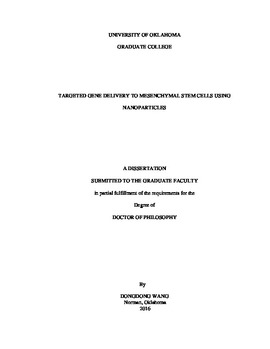| dc.description.abstract | Stem cells hold great potential for the regenerative medicine and tissue engineering. Controlling the fate of stem cell in a reliable method still remains a problem. The strategies for directing the fate of stem cells include biophysical cues (e.g. matrix stiffness, topography, and extracellular forces), biochemical cues (e.g. growth factors, cytokines and chemokines) and cellular reprogramming (e.g. gene delivery). Controlled delivery of specific genes, such as transcription factor encoding genes, to stem cells is a promising strategy for stem-cell based therapy.
Gene delivery methods include two major categories: viral vectors and non-viral vectors. Non-viral gene delivery vectors hold great promise for gene therapy due to the safety concerns with viral vectors. However, the application of non-viral vectors is hindered by their low transfection efficiency. Herein, in order to tackle this challenge, we endeavored to develop non-viral vectors with efficient gene delivery and low toxicity to hard-to-transfect MSCs.
First, we focused on the identification and characterization of novel MSCs-targeting peptides using phage libraries. A peptide (VTAMEPGQ) that can home to rat mesenchymal stem cells (rMSCs) was identified. This VTAMEPGQ peptide demonstrated high affinity and specificity to rMSCs. When integrated into liposome protamine/DNA lipoplex (LPD) system, the peptide significantly enhanced gene transfection efficiency to rMSCs.
Second, we focused on developing efficiently and chemically-defined LPD-based gene delivery system to rMSCs. We employed three-folds reiterated VTAMEPGQ peptides, nuclear localization signal and liposome/protamine complex to delivery vascular endothelial growth factor (VEGF) reporter gene to rMSCs. The developed LPD gene delivery complex demonstrated high transfection efficiency and long-lasting gene expression profile.
Third, we developed Glutathione (GSH) cleavable magnetic/silica nanoclusters integrating MSC-homing major coat protein (pVIII) for targeted gene delivery. pVIII proteins were purified from the VTAMEPGQ-sequence bearing phage identified by phage display technique. The intracellular GSH is responsible for cleaving the S-S bond to dissociate the nanoclusters to release DNA. The as-synthesized gene delivery complex also showed satisfactory gene transfection result to rMSCs.
Finally, we studied the role of cell-binding peptides in directing the stem cell differentiation. We take advantage of the three peptides, which are selected by phage display and show different binding affinities against MSCs, to investigate the osteogenic differentiation of MSCs. Surprisingly, we discovered that the peptide (VTAMEPGQ) with the highest MSC-binding affinity induced the osteogenic differentiation of MSCs most efficiently. We propose that the MSC-binding peptides may bind to the bone morphometric protein (BMP) receptors to initiate the osteogenic differentiation pathway. | en_US |
